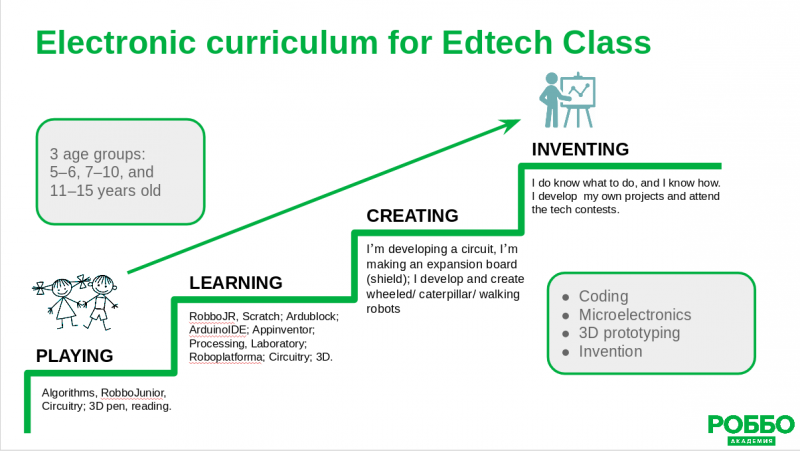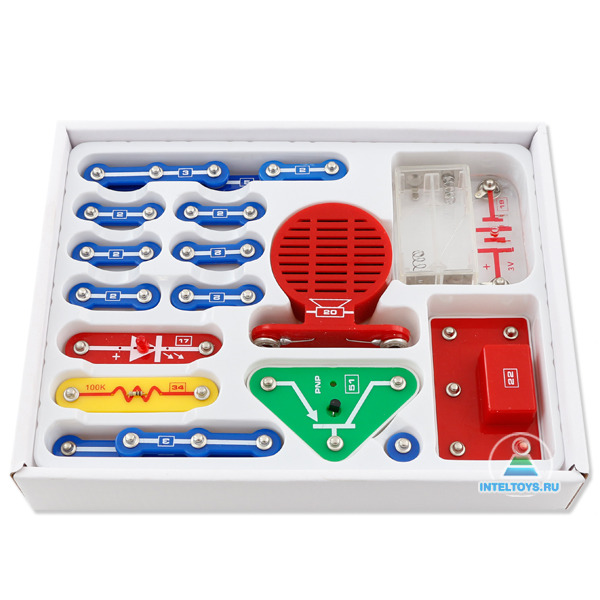ROBBO Class Part 2
This article features the electronic edtech curriculums for engineering innovation class. Training based on such class is intended to form the following competencies: programming (coding); work with a real robot; circuitry and electronics; 3D modeling and 3D prototyping.
The picture shows the stair-steps of competencies that arrive to the competence of a maker, which means a person who is able to create their own new product (electronic device) using materials and technologies.
The training programs exist for each of the three age groups — 5–7, 7–10, and 11–15 years old. The description of each lesson contains detailed instructions for the teacher, a workbook for the student, and a technology card for the lesson.
Consider the ideal trajectory for training a maker.
The first step is play: through a game, children can understand what algorithms and coding are. Coding is introduced through pictograms that are building blocks of the visual programming language RobboJunior. Coding of a virtual hero is gradually developing into the coding of a real robot. A block of circuitry is studied using a children’s kit convenient for this age. The 3D prototyping unit is studied using the 3D pen.
The second stage is the longest, it can take 2/ 3/ 4 years, depending on the readiness and motivation of the student. Programming at this stage uses the blocks, is performed through RobboScratch, and concerns real robots. Projects are created on Scratch, the sensors and robot are worked with, olympiad problems are being solved. The students make acquaintance with the concept of “smart home”, create their own virtual smart home, and control it using Robbo Lab. The electrical circuits of the equipment get more complicated and even programmed, that is, the students make programmable electrical circuits. 3D printer comes in, 3D modeling is deeper understood, their own first 3D models are printed. As the student grows, the complexity of coding also grows: the block coding is replaced with textual, the students can directly program the Arduino microcontrollers. In addition, they study AppInventor, program the mobile devices, and write code to control the robot through their mobile application. The “Expert” kit now includes the electronic components — microcontrollers and breadboard, and knowledge of circuitry and electronics is sufficient to ensure that the student can build their own simple robot, and draw and print the body for their robot on their own. The second stage contains lots of tasks ranging from simple to complex level, and the teacher can arrange the lesson very flexibly and apply individual approach to each student.
The third stage is “creation”: under the guidance of the mentor, a robot is created. At this stage, the student is able to develop a robot schematic diagram, to make an expansion board for Arduino, and to choose various body options for the robot — wheeled/ caterpillar/ walking robot, and in the end they get a completed device.
Then the climbing to the fourth stage of training follows, and it is the top of the stairs. Now, the student is a maker. Anyone who has reached this stage is able to develop an idea and a scheme of their own device, purchase the necessary details, and produce and program their robot. At the fourth stage, the role of the teacher is reduced not to training, but rather mentoring and directing. The student can present all his developments at serious scientific and technical contests, which will be discussed below.
At all levels, projecting and team work is encouraged — for projects or mini projects, students are teamed up, and everyone can try themselves in different roles: project manager, programmer, circuitry designer, 3D architect.
How is the effectiveness of the training provided and maintained? First, the methodical complex was developed jointly with professionals and was highly appreciated. Secondly, the methodological guidelines take into account the special aspects of student’s age, many different activities are offered. It allows to build a lesson very flexibly — basic lessons are combined with a wide range of master classes, intensive courses, and camps. Methodical support and training of teachers is provided.
How is the motivation of students maintained during the sufficiently long and continuous training, lasting from 5 to 15 years? First, the program is interesting. Secondly, it is an approbation of various careers, important for professional self-determination of students. And thirdly, at the end of each module, a final product appears (game, robot, 3D model, etc.) Fourthly, it is useful to test and apply the knowledge and skills in various competitions and contests.
Robbo company is the organizer of various international contests: Creative Programming in Scratch, Robbo club’s Annual Festival, nomination “Robbo Factory” as part of the International IT Planet Olympiad for the makers.
Besides, the skills mastered at working with ROBBO equipment can be applied at the international Robofinist Olympiad; WorldSkills and JuniorSkills. Thus, it can be concluded that the knowledge acquired by the students is not a dead weight, but is actively used both in practice and in various contests and olympiads.


